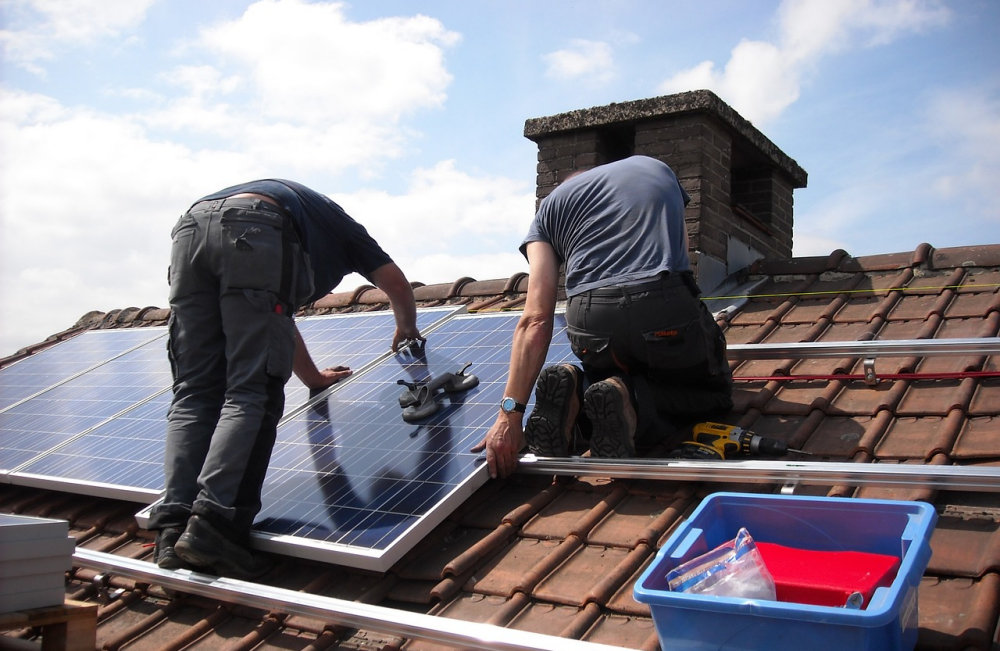Over the past two decades, the US energy sector has experienced industry-wide changes driven by changing public perceptions and a better understanding of the practical benefits involved in clean energy. We can now speak of a generalized switch towards energy efficiency, as people and businesses have become more aware of the multiple ways in which clean energy can improve their everyday lives (1).
Reasons To Switch To Clean / Renewable Energy Sources
Savings and Cost Efficiency
Clean energy is cost efficient and can help save money in household bills. While in the past green energy sources were considerably more expensive to set up and use than fossil fuels, things are changing at a quick pace and the cost of renewables is decreasing year after year. Some reports show that since 2000, US households have saved billions of dollars by taking energy efficient measures (2).
While a large-scale switch from fossil-fuel based energy to renewables requires initial investment, the long-term savings offset the initial costs involved in infrastructure upgrades and the construction of new power plants. In the United States, cost reductions are especially remarkable in energy sources like solar and wind, since there are different types of cost recovery programs that pay off in the medium to long term. Several studies across four main US regions estimate the average savings to range from $65 to more than $240 / person per year, and combined savings amount to billions of dollars (3).
As an example, nationwide the combined savings achieved due to energy efficiency programs during 2016 alone could power 20 million US households. Switching to renewables also makes economic sense given that these energy sources can help stabilize energy prices and avoid the fluctuations that characterize coal and natural gas markets, which are often affected by the changing geopolitical situation.
Clean Energy is Healthier
 It is now well documented that pollution and emissions produced by fossil fuels create public health hazards by reducing air and water quality. The health effects of fossil fuel plant emissions amount to billions of dollars every year, and the human toll is quantified in premature deaths, a rise in respiratory diseases, and increased pressure on healthcare resources. By contrast, some renewable energy sources like wind and solar generate no air pollution, and since they don't require water to operate, no pollutants are discharged into water sources either (4, 5).
It is now well documented that pollution and emissions produced by fossil fuels create public health hazards by reducing air and water quality. The health effects of fossil fuel plant emissions amount to billions of dollars every year, and the human toll is quantified in premature deaths, a rise in respiratory diseases, and increased pressure on healthcare resources. By contrast, some renewable energy sources like wind and solar generate no air pollution, and since they don't require water to operate, no pollutants are discharged into water sources either (4, 5).
Clean Energy and the Economy
Clean energy has economic benefits beyond individual household savings. Renewable energy can bring substantial benefits to the US economy, since this sector could be an important source of employment and revenue generation.
This is particularly true of renewables like wind and solar. For example, according to US Bureau of Labor Statistics, wind energy-related job vacancies could grow by more than 100 percent in a period of 10 years in states with high potential for wind farm development (6). Similarly, jobs in the solar energy sector have been growing at a faster pace than the US economy as a whole - in fact, more than 15 times faster; and solar is the largest employer in the renewables sector after bioenergy, with sub-sectors like advanced grid installation and solar energy storage leading job creation within the domestic clean energy market (7).
So far, growth has been centered around photovoltaics, concentrated solar power, and solar heating, but there are other sectors that can bring high potential economic gains at national scale via job creation, such as clean vehicles and transportation. Overall, the United States is likely to hold to its leading position as one of the top 5 largest global employers in the renewables sector (8, 9).
Renewables and Energy Security
An increased reliance on renewable energy sources can help reduce dependence on energy imports, boosting domestic energy security. This would make the US less vulnerable to global disruptions in the energy market, particularly where coal, natural gas, and oil energy sources are concerned. In turn, this can lead to further decreases in the cost of renewables, since the higher costs associated with imports would not be passed onto consumers (10).
The Benefits of Choosing Energy Saving Options
Small actions and little changes in everyday habits and choices can have a great impact. Efforts to reduce our carbon footprint can be made in many fronts, from the electronics and household appliances we use to our choices of transportation and home building materials (11).
Household Appliances and Electronics
Energy Star rated appliances like refrigerators, dishwashers, and clothes dryers are becoming the standard choice for many US consumers due to the savings they can help achieve. According to the US Environmental Protection Agency, appliance lifespan savings range from $20 to over $400 per appliance (12).
With regards to household electronics, energy consumption monitors are useful devices that provide insights into how and when energy is being used, allowing homeowners to make changes and reduce their overall consumption. Other useful options that are becoming increasingly popular include devices that monitor temperatures (helping to reduce household bills for heating and cooling), smart electronic device chargers that stop using electricity once a device is fully charged, and light dimming systems.
 Vehicles and Transportation
Vehicles and Transportation
Electric and hybrid vehicles (including those used in mass transit systems) offer better fuel efficiency not only at an individual level, but also help reduce the nation's reliance on oil, cut down greenhouse emissions, and improve air quality. These are considered a win-win choice for both consumers and businesses, so it is hardly surprising that the domestic EV market is growing at remarkable rates (13).
Buildings and Construction
The construction sector receives the highest amount of investment within the renewables sector, and is also the biggest consumer of electricity due to requirements involving space heating and cooling, lighting, and water heating (14). Making sustainable choices in building materials can make a difference to the livability of our homes, and an increasing amount of work is being carried out across the US, whether it is through retrofits or new structures, green roofs, recycled materials, and compliance with LEED standards (15).
 In summary, saying yes to energy saving can have tangible benefits beyond those that can be quantified in dollars. Better public health, energy security, benefits to the economy by creating new jobs, and improved quality of life are only some of the advantages involved in switching to renewable as our main source of energy.
In summary, saying yes to energy saving can have tangible benefits beyond those that can be quantified in dollars. Better public health, energy security, benefits to the economy by creating new jobs, and improved quality of life are only some of the advantages involved in switching to renewable as our main source of energy.
Sources & Citations
This Energyboom article contains information and quotations from a variety of sources, including the following:- (1) https://www.americanprogress.org/issues/green/reports/2021/06/29/435281/americas-clean-energy-success-numbers/
- (2) https://www.iea.org/topics/energyefficiency/globaltrends/
- (3) https://www.wri.org/blog/2014/06/shifting-renewable-energy-can-save-us-consumers-money
- (4) https://www.ucsusa.org/clean-energy/renewable-energy/public-benefits-of-renewable-power#.W41x_c5KiM8
- (5) https://cleantechnica.com/2021/01/11/renewable-energy-benefits-people-environment/
- (6) https://cleantechnica.com/2021/02/04/wind-energy-engine-job-creation-across-us/
- (7) https://futurism.com/new-data-shows-solar-energy-creates-more-jobs-america-other-industry/
- (8) https://www.edf.org/energy/clean-energy-jobs
- (9) https://www.cnbc.com/2021/05/09/jobs-in-renewable-energy-hit-10-point-3-million-last-year-report-finds.html
- (10) http://www.cbo.gov/sites/default/files/cbofiles/attachments/05-09-EnergySecurity.pdf
- (11) https://www.energy.gov/sites/prod/files/2013/06/f2/energy_savers.pdf
- (12) https://www.directenergy.com/blog/save-money-energy-star-appliances/
- (13) https://www.theicct.org/publications/consumer-benefits-increased-efficiency-2025-2030-light-duty-vehicles-us
- (14) https://www.iea.org/publications/freepublications/publication/NAM_Building_Stock.pdf
- (15) https://www.energy.gov/sites/prod/files/2016/02/f29/building_america_factsheet_2.10.16.pdf








